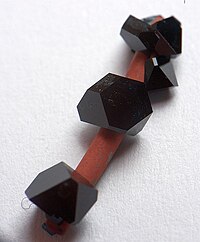I
recently bought some acetic acid, you might know it as vinegar, for
it's acidic properties. Acetic acid is a week acid meaning that it is
relatively safe to use with the main problem being getting it in your
eyes. I recommend wearing eye protection when working with acetic acid. I
know that acetic acid reacts with iron to make iron acetate, but in my
opinion this isn't a very interesting material because it doesn't have
very many uses and the colour is a rather ugly brown. I know that to
make iron acetate you submerse iron in vinegar, and I figured that to
make copper acetate you could do the same and submerse copper in
vinegar. After about a day of letting this reaction happen I checked to
see how it was progressing. The solution had changed very little, all
that had happened was the solution had turned a slight blue colour and
the copper was really shiny. It occurred to me that what had happened
was the acid had reacted with the very thin layer of copper oxide on the
outside of the wire but hadn't reacted with the copper because copper
isn't very reactive. I decide to experiment for a while in trying to
create an copper oxide that would react with the acetic acid. At first I
electrolyzed the solution using copper wires with the idea that the
protons (hydrogen atoms) would be removed from the acetic acid at the
cathode and the hydroxide (water minus a hydrogen) would react with the
copper to make copper hydroxide ( Cu(OH)2 ). I believed the copper hydroxide would react with the acetic acid (CH3CO2H) to make water (H2O) and copper acetate ( Cu(CH3CO2)2
). I was right. The one problem is that the reaction reached
equilibrium, meaning that although there was still reactants, the
reaction couldn’t go any farther because there was too much product
already made. In this case there was enough product made that the copper
in it came back out and started sticking to the cathode in a slimy
sludge-like form. I kept electrolysing the solution but nothing happened
other than more copper slime being produced. All the copper sludge gave
me an idea: what if I took all of that copper sludge and turned it into
copper oxide? I remembered the copper oxide reacting with the vinegar
on the first reaction. Now my only problem was turning the sludge into
copper oxide. I had done so in the past by taking clean copper wire and
electrolysing it in sodium sulfate and then taking the resulting copper
hydroxide, drying it, powdering it, and heating in in a crucible until
it dehydrized and became black copper oxide. I had an idea though. this
was the first time where I had the ability to make semi-pure copper
powder. It had a huge surface area and small volume. This meant it would
be perfect for reacting. I decided the best way to make copper oxide
would be to mix the copper powder with hydrogen peroxide (H2O2)
forming water and copper oxide. I tried this reaction and it worked. My
next step was to add the acetic acid. This worked too. I waited until
the reaction was done and observed the result. It was a dark, green,
clear liquid. I looked online to check and make sure that what I had was
copper acetate. Interestingly enough, aqueous copper acetate was blue,
not green. I decided to filter the product and see if I could get a
different result. Nothing happened. I poured the solution in a jar and
let it sit for the night, when I checked it the next day there was a
layer of clear-green slime on the bottom of the container and the rest
of the solution was a clear dark-blue. I refiltered the solution and got
the result I was looking for: a clear dark-blue solution. When dried,
dark green-blue crystals were formed and when dried slowly larger
octahedral crystals formed. Through further experimentation I determined
that a 1:1 ratio of vinegar and acetic acid was sufficient and optimal
for reaction the copper into copper acetate. Although my crystals were
not as well formed, they looked like this picture I obtained from
wikipedia:

No comments:
Post a Comment